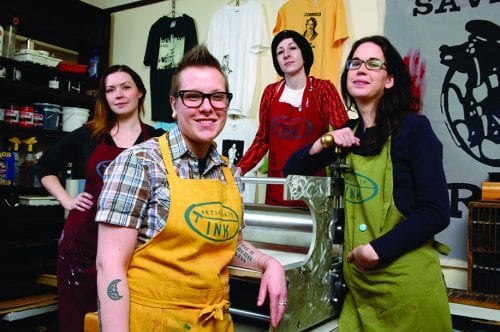Articulate Ink making their mark on the Caligari Festival

author: mac brock | a&c editor

Articulate Ink is ready to keep growing as a staple of Regina’s independent arts scene. Photo credit: Articulate Ink Facebook
Michelle Brownridge, Articulate co-founder, talks studio’s new Caligari exhibit.
The Caligari Festival of German Expressionism has been a regular feature for the arts & culture section this volume, and this issue no different. The Carillon spoke with Michelle Brownridge, co-founder of local print studio Articulate Ink, and coordinator of the Caligari Festival. Articulate Ink is gearing up to host its opening reception for the Caligari Project Print Exchange Exhibition on Thursday, Nov. 17.
For those unfamiliar with Articulate Ink, Brownridge describes it as “an artist-run printmaking center, fostering an active print culture in Saskatchewan through the provision of educational opportunities and accessible print facilities.” The studio was started by Brownridge and three fellow University of Regina alumni in 2010 to provide a space for them and other interested artists to explore the printmaking medium.
According to Brownridge, “Several artists rent studio space on a monthly and per project basis. We also have a store where we sell many different types of hand-printed products and fine art prints.”
Since then, the collective has expanded to a larger space on the second floor of the Creative City Centre on Hamilton Street and hired its first full-time staff member. As artists, their prints have been seen across the province in major gallery exhibits.
Printmaking is often misinterpreted as producing copies of original artwork. Brownridge instead defines the practice as “making artworks by printing, normally on paper, but also textiles and other substrates,” and that prints should not be “considered a copy but rather an original work of art.”
The intricate style of printmaking made the medium a perfect match for the Caligari Festival. Brownridge remembers that “when Articulate Ink heard about the Caligari Project…we knew that we wanted to be involved in some way, because printmaking was a favoured medium among German expressionists.”
She adds that the use of prints went beyond art.
“They used printmaking to distribute powerful utopian messages to the masses on leaflets, portfolios, posters and manifestos.”
Printmakers often recognize Expressionism as being instrumental in their work, as the original Expressionists “often worked in woodcut as a medium,” which Brownridge “hadn’t had a chance to try before getting involved in the Caligari Project.”
The woodcut style is a primary difference between the Expressionist style and modern printmaking.
“In this process, you basically transfer an image to a block of wood and carve out the image areas, then ink it up and print it,” she explains. “I have to say that I am in love with the medium. I love the process and the amount of time that carving the blocks takes.”
The Caligari Project Print Exchange Exhibition, which has been up at the studio since Oct. 25, presents a series of prints done by local, national, and international artists.
“A print exchange is a common practice among printmakers,” explains Brownridge. “For the Caligari Print Exchange, we asked artists to submit an edition of twelve prints,” which are now open to the public for viewing at the Articulate Ink studio. “From those twelve, one complete set of prints will be kept for the Articulate Ink archive, one set will be sold as a fundraiser for Articulate Ink, and then each of the participating artists will receive a portfolio of ten original prints submitted to the exchange.”
The exhibit has drawn attention from a wide range of artists. Locally, “Articulate Ink held a linocut workshop and there are several folks who took that workshop who ended up participating in the exchange and their works are in the exhibition,” and Brownridge adds that “it is really great to see them come full circle like that.”
The local works will be shown alongside prints from across the country and the world, “one being quite a prolific and well-known printmaker in the United States, John S. Hancock, and his print is quite juicy and lovely,” adding to Brownridge’s excitement “to see interest in the Caligari Print Exchange from both inside and outside of our local print community here in Regina.”
The festival, which has been underway since September, “has been quite a wild ride” for Brownridge, whose role in the event is threefold: coordinator for the Caligari Festival, co-organizer for the exchange, and a big part of the daily Articulate Ink operation. Her highlights of the festival so far include “the screening of the 1920 silent film The Cabinet of Dr. Caligari…[as well as] The Caligari Salon at the MacKenzie Art Gallery,” but notes that “it is so hard to talk about the highlights; it has all been an amazing experience, both as an organizer as well as a participant!”
Between last week’s Extra-Vaganza, this week’s production of Spring’s Awakening, University of Regina students have been surrounded by Caligari events for months. Brownridge insists that young people “should care about Caligari because it is a really unique festival…the likes of which has never really happened in our city before.”
Students who want to experience this stunning visual exploration of Caligari and support what Brownridge calls “a truly exciting time to be an artist in Regina” can visit the exhibition during the open hours of Articulate Ink’s retail space, which can be found at articulateink.ca or join them for the opening reception on Thursday Nov. 17 at 6:00 p.m.









